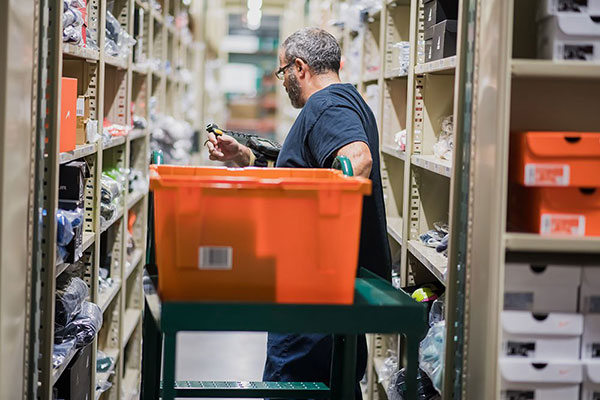The internet, since its adoption in the 1990s, is an amazing place that consistently opens new doors and creates new opportunities.
Business models continue to adapt to our new connected reality. Increasingly, consumers are working their way up the supply chain.
Retailers first felt this push as customers are happy to cut brick and mortar stores out of their daily routine and make purchases directly from the warehouse through digital storefronts.
This has led to the development and dominance of omnichannel distribution models, delivering a variety of goods and brands under one company. They are required to compete with online-only retailers like Amazon. This was a dramatic shift for the distribution center.
The shift continues as consumers keep looking for ways to lower costs. Manufacturers have met this opportunity with direct-to-consumer order fulfillment (DTC). In retail apparel and accessories, 77% of manufacturers have adopted direct-to-consumer models, according to recent surveys.
With ecommerce on the rise, refining strategies for improved operations and labor efficiencies will help better position manufacturers in this competitive atmosphere.
New Order Fulfillment Strategies
Online-only retailers built their entire supply chain around small orders shipping directly to the consumer. These orders are much smaller, generally one to three products, and they ship through a parcel carrier.
Picking these orders is much more labor intensive as workers need to sort through thousands (or millions) of products to find the few items that each customer has ordered. To add to that, the order that “Ryan Reed” placed at 1 a.m. on Tuesday is often expected by the consumer to be received quickly. This often translates to two-day delivery, if not faster.
Online retailers pioneered new order fulfillment strategies to make these scenarios possible, including:
- Demand wave or batch picking
- Unit sortation using put walls and automated sorters
- Goods to person automation
Omnichannel retailers fought to keep up, replacing large areas of their warehouse with storage layouts and picking technologies that facilitate direct to consumer order fulfillment. These look remarkably similar to the strategies used by online-only retailers. If online-only large-scale retailers use put walls, it probably makes sense for an omnichannel retailer to use put walls as well.
Manufacturing Fulfillment Strategies
While brick and mortar stores moved to the digital space and implemented new strategies, consumers continue to look for lower costs. This opened the opportunity for manufacturers to sell directly to the customer, fulfilling orders for their products from their own warehouse and cutting out the retailer.
This sounds great, but now manufacturers are faced with the same dilemma brick and mortar retailers faced in the past. Manufacturers have an entire supply chain built around the delivery of pallets of products to relatively few destinations. Now, they are switching gears to individual product picking and delivering to a multitude of locations.
As manufacturers ramp up selling, and shipping, directly to the end customer, they quickly learn the complexity and labor intensiveness of their new business opportunity. Volumes usually start out small and can be processed with brute force by throwing labor at the problem.
However, eventually sales grow to the point that this strategy is unmanageable. Or, perhaps, a worldwide pandemic simultaneously halts in-person sales AND gives customers more free time to browse the internet for a good deal. Ecommerce orders explode, and everyone struggles to keep up. Manufacturers have the least amount of infrastructure to support this growth.
Strategy Flexibility
It’s a reasonable assumption that manufacturers would look to their ecommerce predecessors to guide their path. If omnichannel retailers and online-only retailers use put walls to fulfill ecommerce orders, manufacturers should use put walls, right?
In my opinion, the answer is a resounding no. Luckily, most manufacturers have a huge advantage over resellers. Namely, they only sell products that they make. Compared to the large-scale, online-only retailers, it’s a much more limited set of products. This gives manufacturers more freedom and options when choosing an order fulfillment strategy.
- On-demand box creation
- Picking directly to carton
- High velocity pick to light picking zones
- In-line weight validation
- Shipping label print and apply machines
These options are only a few of the possibilities but the benefit of flexibility means manufacturers can build out a process that is much more labor efficient than the online-only large-scale retailers.
Adjusting to a Complex Marketplace
While looking to larger retailers for inspiration and guidance on best practices may work in some scenarios, the marketplace is complex and changing with the shift towards ecommerce. Refining strategies for improved operations and labor efficiencies will help better position manufacturers in this competitive atmosphere.
Bastian Solutions helps manufacturers compete in a complex and changing marketplace by coming to the table with proven, cost effective designs for these systems.
Related White Papers
How to Ease Labor Challenges with Advanced Automation
Automation can help a retailer handle everything required with their unique e-commerce fulfillment challenges. Download Now!
Best Buy Answers the Call for Next Day Delivery
To compete in today's fast-paced ecommerce environment, Best Buy, a worldwide omnichannel electronics retailer, needed to revolutionize and modernize its supply chain network. Download Now!
Microfulfillment Strategies – Top Priorities for Retailers
Consumers’ buying patterns have changed the game for retailers - COVID has supercharged the demand for online shopping, same day or even within the hour delivery. Download Now!
Article topics
Email Sign Up



















